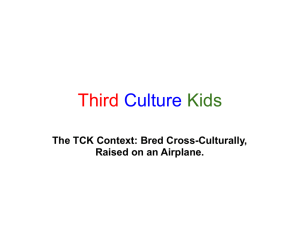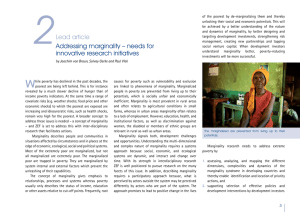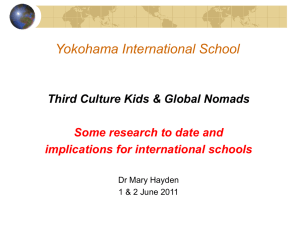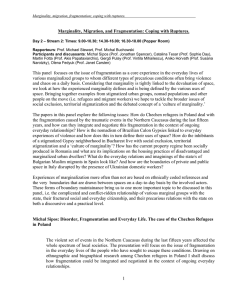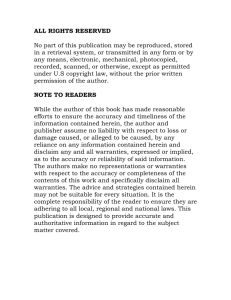05 TCKs 2012
advertisement
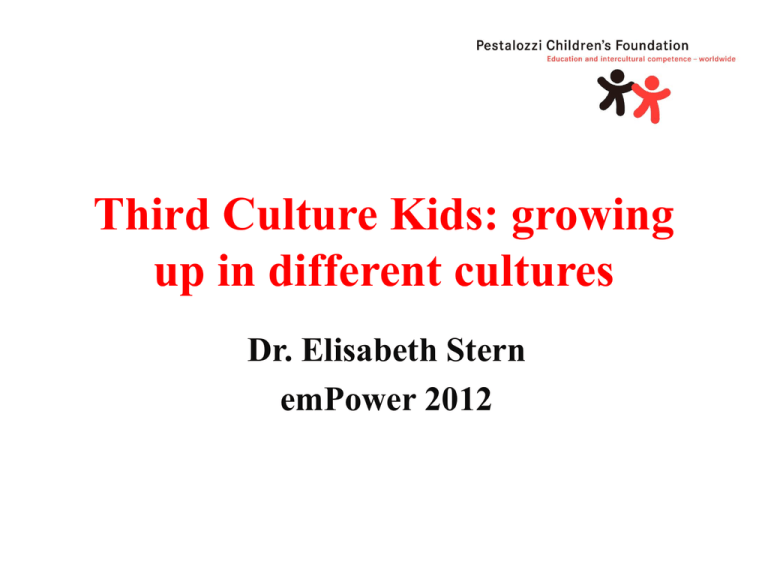
Third Culture Kids: growing up in different cultures Dr. Elisabeth Stern emPower 2012 Who are Third-Culture Kids • The term originated about 40 years ago with Dr. Ruth Useem, a sociologist at Michigan State University/USA. • She and her husband were doing work with US families on overseas assignments. • While working with the adults, she also had an opportunity to observe the kids. She said: «There is something different about these kids. They function at a whole different level. They think differently. They have a different base, and a different point of reference.» • She coined the term Third-Culture Kid. ….alternative terms • Other terms that have been used for these children are Global Nomads, Transnationals, Transculturals, internationally mobile children and missionary kids. Who are Third Culture Kids? • A Third Culture Kid (TCK) is a person – who has spent a significant part of his or her developmental years outside the parents’ culture(s), or – whose parents have each a different cultural background and/or the child grows up in a country different from any of his/her parent’s homecountry. 4 What is unique about TCKs? • They integrate elements of those cultures where they live with their own birth culture into a third, different and distinct culture (Useem, 1999). Third Culture Kids Culture A Culture B Bi -Culturality Internal culture shock Encapsulated Cultural Marginality Constructive Marginality Marginality 6 Cultural Marginality (1) • Cultural Marginality describes an experience in which people do not tend to fit perfectly into any one of the cultures to which they have been exposed to or with which they have interacted, • but they may fit comfortably on the edge, in the margins, of two or more societies, • with an identity that moves beyond any single culture. • Source: Janet Bennett, 1993) 7 Cultural Marginality (2) • Encapsulated marginality results when an individual (TCK) feels overwhelmed by identity conflict, unable to control personal boundaries, and alienated from all reference groups. Such a person never feels at home. • Constructive marginality results when an individual (TKC) can construct his or her own identity, control personal boundaries, and achieve authentic relationships. This person is never not at home. 8 Common Personal Characteristics of TCKs • • • • • Bi- oder multi-lingual Large world view Cross-cultural lifestyle «Home» is everywhere and nowhere Although elements from each culture are assimilated into the TCK’s life experience, the sense of belonging is often in relationship to others of similar background rather than shared race or ethnicity. (David C Pollock, developer of the TCK Profile) Characteristics and skills of TCKs • Can shift codes in nonverbal patterns: can adapt body language, eye contact, touching behaviour • Can shift codes in communication style, from circular to linear, indirect to direct, emotionally expressive to emotionally restraint or vice versa. • Can anticipate value clashes among the various cultural frames with which he or she is familiar. • Uses culturally appropriate conversation rituals and problem solving strategies. • Is able to verbalize cultural contrasts in terms of strengths and limits of each cultural pattern. • Is a bridge builder! Multicultural Identity • In 2000, for the first time ever, the US Census allows individuals to identify as multiracial • Before, being born biracial or multiracial was considered «pathological». • It is possible to have a multiracial and multicultural identity and feel whole and complete (=constructive marginality) • See earlier model by Larke Huang, presented by Véronique Schoeffel. Contact elisabeth.stern@bluewin.ch

